We awoke early in anticipation, and somewhat in dread of the trek ahead of us. We knew that gorilla trekking required we be fit. So we started training with a personal trainer a year ago. Yes, there have been some setbacks – particularly for Melissa who had surgery this summer. But overall, we are in WAY better condition than we were before. Yay us. We hoped it would be enough.
The day started out easy enough with a group of local tribe women performing tribal dances.
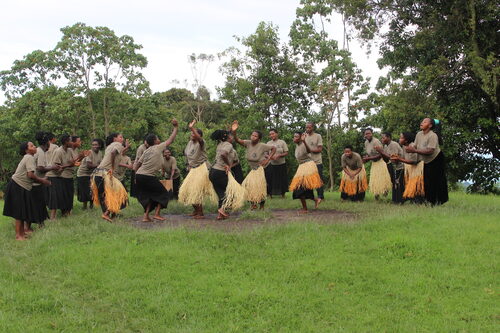
They then demonstrated what was ahead of us with the gorillas.
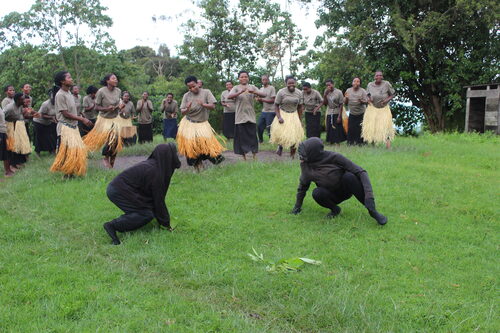
We started out with a lecture about the gorillas. The mountain gorillas have been downgraded from critically endangered at a population of 700 in 2006, to “just” endangered with a population of over 1000 as measured in 2018. They are due for another measurement – and the numbers are expected to go up. They use tracking of the “nests” to approximate the population combined with DNA analysis of feces to track individuals.
Today we are supposed to track a group named “Xmas” after the silverback that was born on Christmas day some years back. Christmas is a famous gorilla in these parts known to be very acclimated to human visitors.
Dave and I debate the porters. The porters are supposed to carry your gear, and will help you up and down the slippery and steep stretches of the road. Dave had left most of the cash in the hotel safe (rightfully so). Melissa wanted both of us to have a porter. Dave was like “one guy to carry the backpack”. Mind you, they are $25 per day. So this is a silly argument but for the fact we were not sure we had enough cash on us. Melissa was sure it was part of the overall package we bought. Ultimately our driver (who had the trek permits too) confirmed we had already paid for a porter each. We will be grateful for this later.
We started off at 9am on the hike. Maybe 1/10th of the way down the hill, Melissa starts to cry. Its unimaginably steep. Her legs are already wobbly from the steep uneven and muddy terrain. Her porter urges her on – holding her hand and just keeps going. Its so steep you can’t even believe it. In places we just slide down the hill. Many of the trekkers just slide on their asses down the hill. Later Dave will measure this all out on google maps. It’s a decent of 400 meters (1300 feet) at an average of 40% slope. There were places we could have rappelled down more easily.
The problem with this is that what goes down, must go up. Every step we make to the forest floor from the village above – is one step we will ultimately have to make going back up.
After a few hours of this we reach the bottom, and the beginning of the hike back up into the forest on the other side of the mountain. Fortunately for us, the advance team (trackers that set out an hour ahead of us) have already located the Xmas troop of gorillas just barely inside the forest perimeter.
So we quietly approach the gorillas. This is literally the first photo we took. And yes, we were as close as this photo implies. This is the silverback known as “Christmas”. If you look closely you will see the silver white hair on his back.
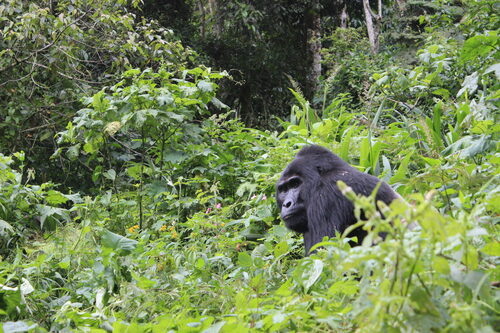
The guides kept cutting through the forest as the gorillas moved so that we could continue to observe them in their natural habitat.
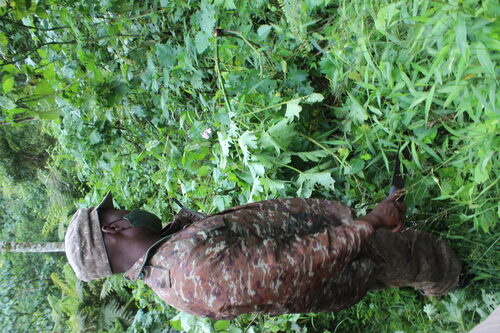
We spent an hour with them. Watching them eat.
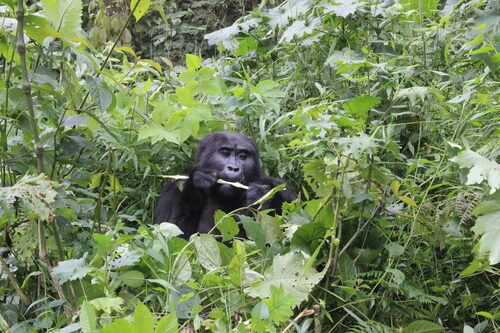
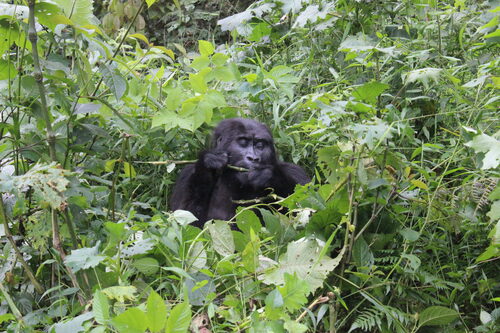
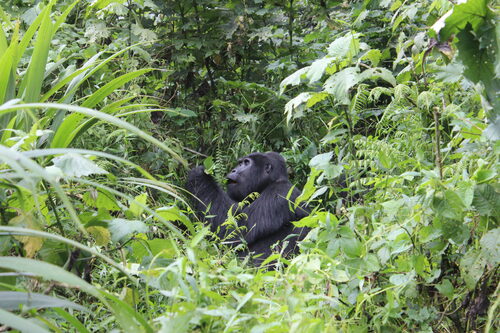
And watching the 4 month old baby.
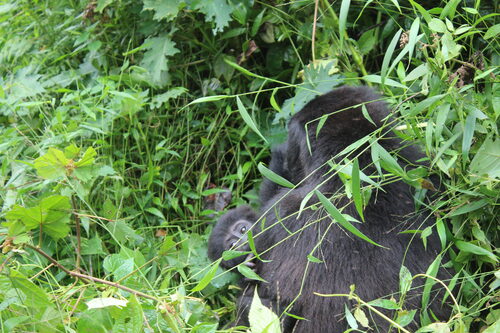
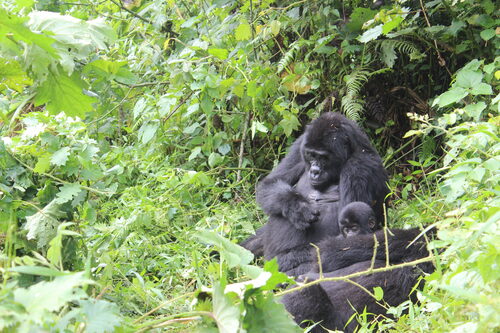
And for those paying close attention, there were some pretty amazing jungle bugs too.
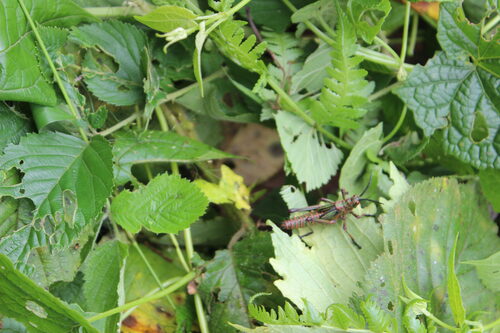
As we were trekking through the forest, Dave slipped and fell. Put his hand down squarely in a sticker bush. The guides plucked him up, but his hand was full of stickers. The guides tried to brush them all off. Alas. Melissa would be picking more of them out with tweezers later in the evening over dinner in our room. This is where we are grateful for Kelly (Melissa’s brother the paramedic) who makes us carry all the first aid gear and anti-biotics.
After our hour long visit with the gorillas, it was time to start the long trek back up the mountain. Melissa was convinced it would be easier to just live with the gorillas from now on. Alas.
To give some perspective, the Columbia Center tower, the tallest building in Seattle is 284 meters (933 feet). We had to climb out 400 meters. In the mud. Over uneven terrain. Yipee. There is a safety lever you can pull. It’s known as the “African helicopter”. The porters – 4 of them – for $60 USD – will take you on a stretcher down the hill and back up again. They told us we could ask for one. Dave comments to Melissa at one point that she can have one but she has to wear a crown that says, “princess”. Ok, yeah, totally worth it, Melissa replies. But the group has to stay together. We have guides and military escort with AK-47s. For the possibility of the occasional mountain elephant we are told. But regardless, we all have to stick together. So unclear how long to get the additional porters down to us with the stretcher. And its so slippery – how will that work anyway?
Yet we slog on. Melissa asthma is so bad, combined with the 7000 ft altitude that she has to stop about every 10 meters and catch her breath. At one point she is breathing so hard she strains chest muscles on both sides. Ouch. Ouch. Ouch.
Yet we slog on. We finally reach the outskirts of the town where there is an open field and stop for lunch. We lay out our rain jackets on the grass and sit. Melissa is not sure she will ever get up again. We’ve only gained 150 meters of the 400 we have to do. She stares up at the mountain thinking “no way in hell”.
Yet we slog on. Thank goodness there is one other gal in our group that was struggling and going slow too. The irony is that the young folks on the trip would forge ahead and then sit and wait for us slow folk. So they got to rest, and when we caught up, it was near time to move on again.
Yet we slog on. The running joke with the lead guide became that we are “almost” there. We did the worst part coming out of the forest at the bottom of the valley. Now we are on the “second most worst part”. And near to the “third most worst part”. This made all the porters and guides laugh.
Yet we slog on. The value of the porters has become clear. One is pulling Melissa up the hill and the other is pushing her up each step. Had it not been for this, she would have blown out a knee for sure on the rocky and often steep terrain.
We finally, after 5 hours since we started, arrive back at the cars. Melissa’s legs are so weak she can barely stand. This was much, much, much worse than Machu Picchu, and Melissa knows tomorrow she is going to pay. Dave did pretty well. (Insert Melissa swearing here.) Our trainer, Orson, will be happy to hear it.
The permits we were issued for tracking cost $800 per person per day (and only 16 to 24 are issued in this area per day). We were supposed to trek for two days in a row. No notion of what the travel agent was thinking here. Most people trek for a day. When we arrived back at the lodge, Melissa’s words were “not one chance in hell”. We donated the second day of trekking to our driver, and his buddy, the lodge handyman.
As an aside, we learned that an hour drive from here is a gorilla trek that is much, much easier. Completely unclear why the travel agent booked us on the trek from hell when there was another option.
Somewhere along the way Melissa lost a lens cover. Dang it.
For those that might doubt that this gig is not for the faint of heart… the next day a group of people from our lodge went gorilla trekking at another location. There the gorilla group was not yet acclimated to human observation. The guide was viscously attacked by the silver back gorilla. One of the other tourists was in a tug-o-war with the gorilla for control of the guide. Ultimately the gorilla let go. Later the guides admitted that this has never happened before and it scared the bejesus out of them.
This post wouldn’t be complete without a few words on the gorilla themselves. The mountain gorillas that we saw were critically endangered in 2006 with a population around 700. Efforts of Uganda, Rwanda, and the Congo have increased their numbers to over 1000 as last measured in 2016 upgrading them to the endangered list.